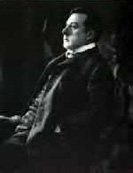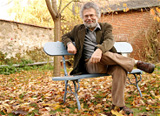L’Hirondelle et la Mésange

- Production : France, 1920
- Length : 79 min at 18 frames/second
- Orchestration : 1st violin, 2nd violin, Viola, Cello, Double Bass, Clarinet, Piano, Accordeon, Flute, Saxophone, Percussion
Scenario :
The action of the film takes place on the canals in northern France on board two barges, L’Hirondelle and La Mésange, which transport coal and other commodities to regions deprived by the 1914–18 War. Their captain is Pierre Van Groot, helped by his wife, Griet, and sister-in-law, Marthe.
Pierre takes on a new pilot, Michel. Marthe falls in love with Michel but the pilot tries to take advantage of Griet. In addition, Michel knows about the diamond traffic which Pierre indulges in from time to time and also knows where the jewels are hidden. The two men eventually come to blows…
The Director :
André Antoine
 André Antoine (1858-1943) : A simple gas company employee, André Antoine very quickly gave way to his passion for the theater and in 1887, founded the Théâtre Libre where he broke with the classical staging traditions. He was director of the Théâtre de l’Odéon from 1906 to 1914, but his exuberance entrained excessive costs and he was only saved from bankruptcy by a gala organised by his friends in 1914.
André Antoine (1858-1943) : A simple gas company employee, André Antoine very quickly gave way to his passion for the theater and in 1887, founded the Théâtre Libre where he broke with the classical staging traditions. He was director of the Théâtre de l’Odéon from 1906 to 1914, but his exuberance entrained excessive costs and he was only saved from bankruptcy by a gala organised by his friends in 1914.
Between 1915 and 1921 he devoted himself to the cinema and made ten movies, many of which rejected the studio-bound conventions of the time. L’Hirondelle et la Mésange, filmed entirely on location in Flanders in 1920, was refused by its distributor. and shelved for over 60 years. The movie was finally completed and shown by the Cinémathèque Française in 1983.
The Director :
Raymond Alessandrini
 Raymond Alessandrini began his musical studies at the age of five and attended the Conservatoire National Supérieur de Musique de Paris. He finished his studies at the age of eighteen, having obtained first prizes for piano and chamber music. He embarked on a career as a piano soloist, at the same time continuing his studies in composition. Within a short time he became an arranger and studio pianist which enabled him to record for such prestigious composers as Lalo Schiffrin, Elmer Bernstein, Alfred Newman and Georges Delerue. It was thanks to the latter that he was able to take his first steps in the world of the cinema. In the following 15 years, he composed around forty film scores, the principal directors being : Jean-Charles Tacchella, Jean Yanne, Georges Lautner, Tony Gatlif, Michel Wyn.
Raymond Alessandrini began his musical studies at the age of five and attended the Conservatoire National Supérieur de Musique de Paris. He finished his studies at the age of eighteen, having obtained first prizes for piano and chamber music. He embarked on a career as a piano soloist, at the same time continuing his studies in composition. Within a short time he became an arranger and studio pianist which enabled him to record for such prestigious composers as Lalo Schiffrin, Elmer Bernstein, Alfred Newman and Georges Delerue. It was thanks to the latter that he was able to take his first steps in the world of the cinema. In the following 15 years, he composed around forty film scores, the principal directors being : Jean-Charles Tacchella, Jean Yanne, Georges Lautner, Tony Gatlif, Michel Wyn.
He became more and more interested in this form of composition and thanks to the help of George Delerue, he was able, from 1982 onwards, to consecrate more of his time to film music without neglecting, however, his activities as a classical pianist and teacher. A determining factor in his career as composer for the cinema was his collaboration with the film-maker and editor, Henri Colpi, and with the Cinémathèque Française for André Antoine’s film, « L’Hirondelle et la Mésange ». Other scores followed for the silent cinema such as René Clair’s « Un Chapeau de Paille d’Italie », Augusto Genina’s « Totte et sa chance » and Erich Von Strohen’s « Greed ». He is also the author of several concert and theatre works.
 English
English Français
Français











